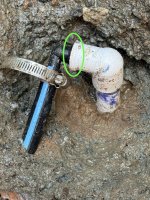As I was looking at a spot of completely saturated dirt with standing water on top of it in front of my equipment pad, it occurred to me that it hasn’t rained in about two weeks here in Atlanta, and so this water at which I’m blankly staring is probably A Bad Thing.
I’m the proud owner of this pool/house for about two weeks now, so I’m new to this game. What would you do if you were relatively DIY inclined? Start digging at the wet spot, presumably delicately so I don’t hit / break a PVC pipe? Just call the pool builder?
Unfortunately, nothing above the surface seems to be leaking; that suspiciously close main drain on the filter is bone dry.
I’m the proud owner of this pool/house for about two weeks now, so I’m new to this game. What would you do if you were relatively DIY inclined? Start digging at the wet spot, presumably delicately so I don’t hit / break a PVC pipe? Just call the pool builder?
Unfortunately, nothing above the surface seems to be leaking; that suspiciously close main drain on the filter is bone dry.





